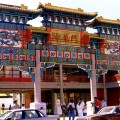Vancouver has the biggest Chinatown in Canada, boasting a history of more than a century. When the City of Vancouver was incorporated in 1886 a small Chinese settlement had already developed at Shanghai Alley near what is now Pender and Carrall Streets. Soon, it started to develop along the shores of False Creek adjacent to Gastown. Though Victoria was the port-of- call then, Vancouver was dubbed "Salt Water City" by the Chinese and was their favorite city for settlement. Smaller groups of Chinese laborers, farmers and merchants were also found in Nanaimo and New Westminster.
The typical Chinatown building at that time was a two-storey wooden structure with a storefront on the ground floor and the residence and meeting rooms tucked in on the second floor The area was often cramped, run-down and dirty. Many of the buildings now standing in the commercial and tourist centre were built by different clan associations in the early 1980s. The architecture of these three-storey brick buildings with recessed balconies and decorative metal railings were modeled after structures in Southern China.
In 1971 the municipal government quelled the growth of Chinatown by declaring it an historical area where all old buildings of significant value were to be preserved and new development strictly controlled. This designation was a blessing in those years as it helped fight proposals for a freeway across the heart of the area. A decade later, however, the heritage classification turned into a curse by stalling development in the district. Meanwhile Chinatown underwent two "beautification projects". New lampposts, phone booths with oriental designs and colorful banners added festive charm to Chinatown while modern shopping arcades such as the Golden Crown Centre and the Golden Gate shopping mall gave the area a face-lift.
Today Chinatown is a lively cultural centre frequented by the Vancouver Chinese community and tourists alike during weekends and Chinese festivals. To many of its patrons it is also a commercial hub with its 13 financial institutions and numerous professional services where business can be carried out in the mother tongue. Both the Sun Yat-sen Garden, a major attraction featuring classical Ming Dynasty garden architecture, and the Chinese Cultural Centre which hosts a variety of cultural events, were built with support from the city. Plans for a new wing in the centre to house a museum, library and retail scores are now in the pipeline. Restaurants offering savory cuisines, shops specializing in famous Southern Chinese barbecue meat, Chinese herbs, health foods, seafood, groceries and articrafts, and theatres showing Chinese opera and film line the busy streets bounded by Hastings, Georgia, Jackson and Carrall. Chinese from many different parts of the world come here for a taste of their old traditions. To this day clan and locality associations, tongs and cultural societies still attract the ethnic Chinese community, even when pitted against the modern Concord Pacific project to the immediate east of the area.
The Chinatown Merchants Association worked very hard to maintain its vitality in the mid 1980s when suburbs such as Richmond, Burnaby and Coquitlam started to develop into major Chinese settlement areas, drawing substantial business away from their merchants. Its greatest task in the last decade has been fighting for the construction of a 100-car parkade (which materialized in 1995), part and parcel of a huge development plan funded by local and offshore investments. Other major milestones in the rejuvenation of Chinatown are the new Chinatown Plaza which accommodates the largest Chinese restaurant in Canada, seating 1,000 people in total, and the new Wayfoong House which houses Hongkong Bank's Chinatown branch serving about 20,000 clients. Their business catchment area will no doubt be further broadened with residential projects in the neighborhood such as the International Village. Citygate, General Motors Place and 84 residential units with retail outlets in the 200-block East Georgia are complete. It should also draw a good mix of upscale residents who used to shun the area because of its proximity to the Downtown Eastside.

